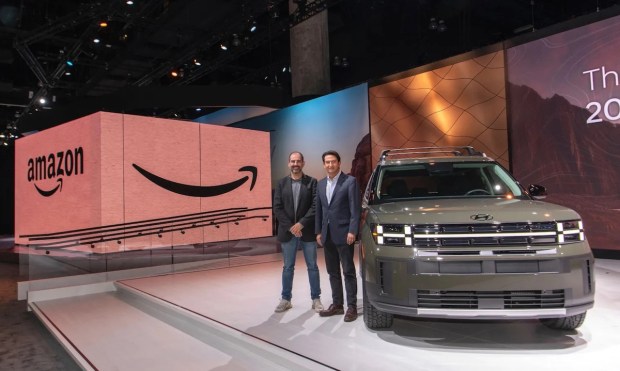Amazon Puts Alexa in the Driver’s Seat, Walmart Revs Up Package Delivery

Amazon and Walmart are revving up their engines with initiatives set to hit consumers by the year’s end or the start of 2024. The projects go full throttle on transportation and delivery, but the road diverges when dissecting each retail giant’s strategy.
Beginning in 2024, Amazon customers will have the opportunity to discover and buy Hyundai vehicles directly through Amazon’s U.S. store. This marks one of numerous initiatives forming a new strategic partnership between the automotive company and the tech giant.
The digital shopping experience allows customers to browse vehicles based on preferences and complete the purchase online. They can then choose to pick up the vehicle from their local dealership or have it delivered to their doorstep.
The initiative simplifies the car-buying process and provides dealers with an additional platform to showcase inventory and increase customer convenience.
Alongside the option to buy a car, beginning in 2025, Hyundai’s next-generation vehicles will integrate the Alexa Built-in experience. The integration enables drivers to access Alexa’s features and capabilities hands-free while on the road.
Using voice commands, drivers can play music, podcasts or audiobooks, set reminders, update to-do lists and manage their smart homes. Alexa will also offer real-time traffic updates and weather reports, along with control over the in-vehicle media player and navigation system.
PYMNTS Intelligence found the compound annual growth rate for the global automotive software market is projected to be 15% by 2030.
Connected vehicles will bring a range of features and benefits to both consumers and commercial fleets.
Why Amazon’s Foray May Drive Consumer Excitement
Amazon’s collaboration with Hyundai signals a transformation in the automotive retail scene. The perks of online car shopping highlighted in this partnership encompass enhanced convenience, transparent pricing, review accessibility, seamless customization, efficient transactions and improved customer support. Moreover, it has the potential to alleviate the stress associated with traditional dealership visits. In this regard, Hyundai’s move resonates with the prevailing trend of leveraging digital platforms for automotive purchases.
Several other platforms have already embraced the trend of online car sales, responding to the changing preferences of consumers. Companies such as Tesla, Carvana and Vroom let customers explore, personalize and purchase vehicles entirely through digital channels. These platforms emphasize transparent pricing, comprehensive information and simplified transaction processes, contributing to a more user-friendly and customer-centric car buying experience.
Walmart’s Side of Things
Simultaneously, Walmart is incorporating parcel stations into its stores to function as delivery hubs.
The retailer aims to have over 40 parcel stations operational in stores by the year’s end, with many in service for the holiday season. Walmart further intends to extend this capability to additional locations in the upcoming year.
In practice, parcel stations function “like a mini post office that receives and delivers packages,” Jennifer McKeehan, senior vice president of transportation and delivery at Walmart U.S., said in a statement.
“Parcel stations help us move goods even faster to a customer’s home by using our Private Fleet to transport more online orders,” McKeehan added in the statement. “Packages originate in our fulfillment centers and move to a sortation center or directly to stores, where they are then delivered to a customer’s home using our last-mile delivery network.”
Why Walmart’s Delivery Effort Could Shift Consumer Gears
The initiative not only enhances the customer experience but also benefits associates and the overall business. For customers, the introduction of parcel stations provides increased flexibility when placing online orders.
With a broader range of products available for next-day delivery, customers can shop and promptly receive their purchases.
For associates, the implementation of parcel stations simplifies the distribution process of online orders from Walmart stores. This streamlining improves efficiency, making it easier for associates to fulfill orders and ensuring timely delivery to customers.
Walmart emphasized that by optimizing the distribution process, it can increase density and reduce delivery costs, resulting in savings that can be reinvested to enhance the overall customer experience.
The expansion is designed to improve customer service by providing speed, accuracy and reliability. Additionally, it aligns with Walmart’s GoLocal initiative, aiming to support other businesses.
“Today, customers value home delivery as their preferred online fulfillment method,” McKeehan said in the statement. “Parcel stations are yet another step we’re taking to give them what they want and more, and we’re looking forward to hearing their feedback.”
Walmart reported during its quarterly earnings call Nov. 16 that in-store fulfilled pickup and delivery contributed to a 24% surge in eCommerce in the third quarter.
For all PYMNTS retail coverage, subscribe to the daily Retail Newsletter.
